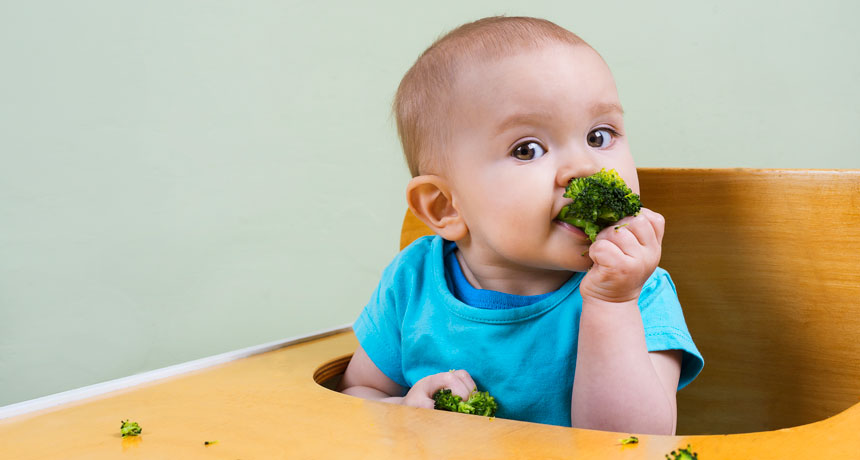Baby-led weaning is safe, if done right

When babies are ready for solid foods, the meal usually arrives on a spoon. Parents scoop up pureed carrots, liquefied banana or soupy rice cereal and deliver it straight to their baby’s mouth (or forehead). But a different way of introducing solids is gaining ground. Called baby-led weaning, the approach is based on letting the baby feed herself whole foods such as a soft pear or a spear of cooked broccoli — no spoon required.
Advocates say that by having control over what goes in their mouths, babies learn to regulate their food intake, refine motor skills and perhaps even become more adventurous eaters. But critics fret that inexperienced eaters may be more likely to choke on solid foods that they feed themselves. A new study of about 200 Australian babies has some reassuring news: Provided that certain risky foods were avoided, babies who fed themselves solid foods were no more likely to choke than spoon-fed babies.
Half of the babies started solid food the traditional way, with parents spoon-feeding them purees and other mushy foods. The other half were given solid foods on their trays and encouraged to feed themselves. Parents were told that babies ought to be sitting up and in the presence of a caregiver while eating. And parents also received a list of risky foods to avoid: hard crackers, diced or hard meat, raw vegetables and popcorn made the list. (A general rule of thumb for checking whether the food is safe: If you can squish the food against the roof of your mouth, then it’s probably OK for your baby to try.)
Spoon-fed babies choked just as much as babies who fed themselves, the researchers report in the September Pediatrics. At 6 months of age, about 22 percent of spoon-fed babies had choked at least once. In the baby-led weaning group, about 18 percent of babies had choked at least once. Choking rates between the two groups were on par as the babies grew older.
There’s an important distinction here between gagging and true choking. Gagging is common among babies as their mouths learn to handle new textures and flavors. The throat slams shut and the mouth tries to get the offending food out. A gagging baby may have watery eyes, push his tongue out of his mouth and make retching movements. He may even puke. This can be hard for parents to watch, but gagging isn’t dangerous.
True choking is. This is when the airway becomes partially or fully blocked. The baby may cough or sputter in an attempt to dislodge the food. He may make a raspy, squeaky whisper as he tries to communicate distress. Or he may go silent. It’s always good to be up on infant CPR, particularly if you’ve got a new eater.
The babies who fed themselves seemed to quickly hone their skills. Initially, self-feeding babies gagged more often than spoon-fed babies at 6 months of age. But by 8 months old, self-feeders had become experts, gagging less than spoon-fed babies.
Although the news seems good for parents who want to try baby-led weaning, the research also turned up something concerning: Lots of babies were given risky foods, regardless of feeding style. At seven months of age, just over half of babies were given something from the no-feed list. By 12 months, almost all the babies had been given riskier foods that can lead to choking. Hard crackers, meat and whole grapes topped the list.
The results suggest that whether you feed your baby or you let your baby feed herself, it’s still important to pay attention to the type of food that’s going into her cute little mouth.